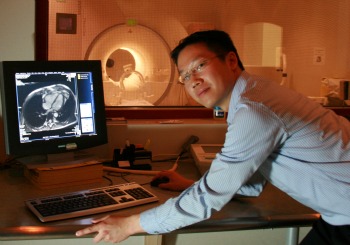
Biomedical engineering PhD student Kelvin Chow earned his degree in engineering physics and is now conducting high-level research into cardiac MRI imaging.
Edmonton-When Kelvin Chow has always been interested in helping people. While going to high school, most of his friends talked about going into medicine but Chow was leaning towards engineering. He discovered a way to combine his passion for math and physics with his desire to help heal the sick, by studying engineering physics.
Today, he's earning a PhD in biomedical engineering, conducting leading-edge research in medical imaging that could improve treatments for patients suffering from heart disease.
"I really love my research," said Chow. "I'm lucky to be doing something that I love, and knowing that it could make a difference in people's lives."
Chow says the engineering physics program gives him the "perfect background" for his current research. Working with Department of Biomedical Engineering professor Richard Thompson and cardiologist Dr. Ian Paterson, Chow is pushing the boundaries of magnetic resonance imaging technology to find ways of getting even better images of patients suffering from cardiac disease, focusing on swelling and scarring to monitor disease progress and help doctors understand the condition of their patients and treat them more effectively.
"Basically, I play with magnetic fields and radio frequencies trying to find different ways to excite tissues so we can get better images," he said. "Typically, what we are looking for in an image is contrast. For example, edema is swelling and with swelling there is water, and we can see that with an MRI. Edema is an active injury and it is something you can see right now."
Chow's first research experiences came through undergraduate student research awards from the Natural Sciences and Engineering Research Council, and he hasn't looked back.
In working with MRI imaging, Chow is able to set up and perform experiments in short order, providing research results to clinicians in short order.
"In our research we want to benefit patients. We want to answer questions that clinicians have and improve patient care, and having close ties with the clinical side really helps. So one week you can have an idea for an experiment and the next week you can be trying it on patients. Having those clinical partnerships is a major benefit."
Chow's immediate plan is to earn his PhD. After that, he's unsure: he can either follow an academic and research career path, or become a medical doctor. "I'd like to be a doctor-I'd like to see patients; I'd like to be their physician. Cardiac MRI will be my future, but the question now is which side I approach it from."